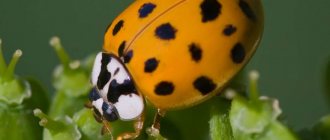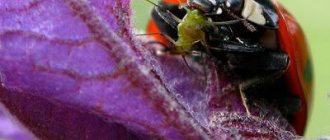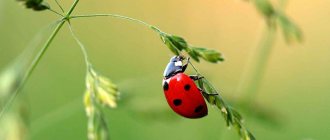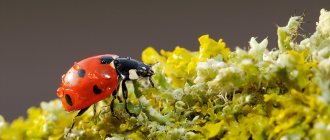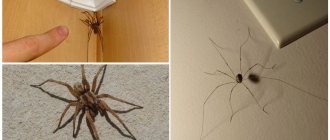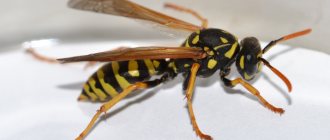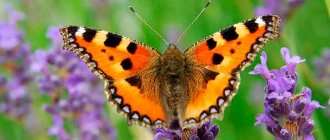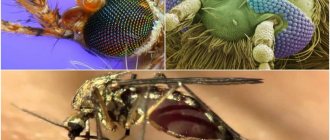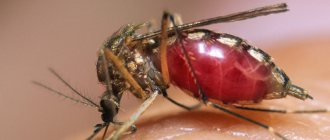What is the relationship between ladybug and aphid. Why is ladybug considered the best remedy against aphids? What you need to know about these insects. How gardeners attract ladybugs to their plots. Popular beliefs. Facts about ladybugs.
We are all familiar with such cute insects as ladybugs. They are capable of not only charming with their rather bright appearance, but are also capable of bringing great benefits to gardeners, as they are ideal assistants in pest control.
It is worth mentioning that for a long time entomologists have been observing the relationships of ladybugs with other insects. It was discovered that the ladybug and the aphid are not on friendly terms. The ladybug destroys the pest, which has become the reason for the widespread use of beneficial insects in agriculture.
Pests
A pest such as aphids is a small, sedentary insect. Adults grow to a maximum length of 8mm. The pest's diet consists of plant sap.
The mouthparts consist of a proboscis, with which they easily pierce the leaf plate and suck out the juice. Aphids secrete a very sweet and healthy substance - honeydew, which ants love. Therefore, very often, when infested with aphids, an anthill is observed in the area.
This small pest is a carrier of dangerous diseases that lead to the death of plants.
They live in fairly large colonies and prefer a mild and warm climate. There are winged and wingless representatives. In autumn, females lay eggs in the bark of trees, near the buds, where they easily survive the winter.
With the arrival of warmth, wingless individuals emerge from the eggs, which attack young plants and begin to actively feed. They can lay offspring without mating, so intensive population growth is observed.
By mid-summer, females with wings are born, which fly to other plants and create new colonies. It is their clutches of eggs that can overwinter, and in the spring everything repeats again.
Prevention
Preventing a problem is always easier than dealing with its consequences. Therefore, along with the listed measures to attract natural enemies of aphids, you can also use other prevention methods:
- Find and destroy anthills. This can be done with boiling water, hot ash from a fire or oven, finely chopped garlic (cloves and herbs), urine, soda, tar, cinnamon.
- Excess weeds should be removed at the end of each season. Before planting, remove all dead wood, remaining leaves and debris.
- Carefully inspect grasses, bushes and trees for signs of damage.
- Whiten apple trees and other garden trees. It is better to do this both in the fall (in October) and in the spring (in April), since moisture erodes the white.
Thus, the fight against aphids is quite possible without the use of special chemicals. However, if this pest has spread too abundantly in the area and there is an affected plant in almost every bed, insecticides should be used. These could be the following:
- "Spark";
- "Corado";
- "Aktellik";
- "Fufanon";
- "Commander";
- "Fury" etc.
The treatment is carried out in strict accordance with the instructions, after which most of the pests die. However, subsequently it is better to use only natural methods of protection, so as not to destroy beneficial insects.
Ladybug
Ladybug activity begins in the spring and continues until late autumn. As a rule, in those places where they spend the summer, they remain for the winter, hiding under fallen leaves, in the bark of trees, under stones.
But there are also ladybugs that do not stay in one place, but migrate. These insects do not live in colonies; they prefer to lead a solitary lifestyle. But before the onset of cold weather, when they are about to fly or winter in place, they gather together in groups. Mass gatherings can also be observed during the mating season.
These insects are among the first to wake up after a long winter. It is enough for the air temperature to reach +10°, so they can be observed very early in the spring. Life expectancy is on average 10-12 months, in rare cases representatives can live up to 2 years, this largely depends on the availability of food.
The size of these bugs is 4-10 mm and they live alone. When they are on the ground, their wings protect them from predators. In 1 second, this bug can make up to 85 strokes, for this reason most vertebrates, as well as birds, avoid it.
In addition, even tarantulas and lizards do not dare to hunt a ladybug. Protection is also provided by a yellow liquid with an unpleasant odor, which they secrete when in danger.
You can meet them in the steppes, forests, forest edges, and gardens. They fly quite high above the ground. In mid-spring, the mating season begins, and at this time the female emit a specific smell that attracts males. The females then lay eggs in the foliage. In winter they gather in groups and hibernate together.
The life cycle consists of the following stages of development:
- Egg.
- Larva.
- Doll.
- Imago.
Once the larva emerges from the egg, it is very similar to an ordinary pest beetle, but if you examine the individual, you can see barely noticeable red spots on the sides, which give the insect its identity.
For habitat they choose grass meadows, shrubs, and grain crops. They are predators, so they search for aphids, which are their favorite food. In the case when she does not find aphids, her diet may consist of spider mites, small caterpillars, whiteflies, scale insects, and scale insects.
Life cycle of coccinellids
Coccinellidae is one of the largest families of Coleoptera. They lead an isolated lifestyle, but gather in large groups for the winter. Insects migrate to favorable conditions, often finding refuge in the mountains among stones. Before the onset of cold weather, a colony of several million individuals can gather. Not all beetles migrate; many overwinter near the fields where they lived in the summer. They hide under fallen leaves, branches, grass.
In the spring, insects wake up and fly to gardens and fields to look for food. The ladybug eats aphids and accumulates energy for reproduction. Fertilized females lay eggs and then die. Usually, with sufficient nutrition, coccinellids live for 1 year; in some cases, the life cycle extends to two years. In their development they go through 4 stages:
- egg;
- larva;
- chrysalis;
- imago.
Small dog breeds. Description, features, names and types of small dogs
Reproduction
Sexual dimorphism of beetles is weakly expressed; outwardly it is difficult to distinguish a male from a female. Ladybugs use pheromones to attract partners. The female takes care of the nutrition of the offspring in advance; she lays eggs close to the developing colony of aphids. During the season, the female lays from 200 to 600 eggs. They are usually oval shaped and yellow or orange in color. They are arranged in even rows, the masonry is 15-25 pieces. The hatched larvae are 1-2 mm long; the little ones are unable to hunt, so they eat the eggs of pests. The offspring grows quickly, after a month their body reaches 8-10 mm.
Ladybug larvae are small predators
The larvae go through four instars and live openly on plants. The body is dark green or black, it is covered with a yellow or red pattern. There are noticeable growths and warts on the back. Ladybug larva and aphids are irreconcilable enemies. The offspring of predatory beetles destroys several thousand pests, their larvae and eggs to the adult stage. At the age of four weeks, pupation occurs. After 10-12 days a small beetle appears. It takes some time for the elytra to harden. Juveniles are distinguished by their bright red color, which fades somewhat with age.
Attention. Larvae need a large amount of food for active growth, so they eat more often than adult insects. Farmers have noticed this quality; they use the offspring of cows to destroy greenhouse pests.
Ladybugs have enemies in nature. These are hymenoptera (riders) and bugs. They parasitize insects in the larval and pupal stages.
Predatory beetles and their larvae provide significant assistance to agriculture. To prevent pests from bothering your garden and vegetable garden, it is worth building houses for cows. A log with a drilled out center is suitable for this. Insects can spend the winter in this shelter.
Attracting beneficial bugs
Of course, in order for these useful bugs to appear on your site, you need to try a little. To do this, plants are planted in areas that attract ladybugs.
There are quite a lot of such plants, for example:
- Calendula. Beautiful and fragrant flowers called marigolds. It is a medicinal plant and belongs to the sunflower family.
- Cornflowers. An equally beautiful plant that blooms in spring or autumn. Can grow up to 100 cm in height.
- Dill. An aromatic spice that will be useful in any area.
- Dandelion. A very common and unpretentious plant that loves sunny places.
- Mint. A useful and very popular medicinal herb that is easy to care for, but it is better to plant it away from others.
- Coriander. Attracts ladybugs during growth and flowering. Used as a spice. Blooms during June-July. Requires regular watering.
- Cosmea. A very beautiful plant that will delight you with flowering from June to September. Should be planted in a sunny place.
- Ammi. It is an annual plant. It can reach 30–100 cm in height.
- An annual herbaceous plant, has a height of 30 to 100 cm.
How to attract beneficial insects?
In addition to aphids and insects, ladybugs also eat pollen. And the pollen of some plants is preferable to them than the pollen of others. Examples of herbs that can be planted in your area to attract beetles include:
- Calendula is a perennial herbaceous plant. Grows well in bright sun. Blooms in a lush bright orange palette. Attracts ladybugs.
- Dill is an unpretentious green plant that is extremely effective in attracting beetles. A widely used spice.
- Cornflowers are a perennial plant that attract ladybugs well.
- Coriander is a wonderful spice that attracts beetles during flowering and growth.
- Geranium - this unpretentious plant will also help you attract ladybugs.
- Tansy is a decorative and quite useful plant in our topic.
- Dandelion - surprisingly, but such a familiar herbaceous plant to us, is also extremely effective in exterminating aphids.
- Cosmea - this amazing flower can become not only a wonderful garden decoration, but also an equally pleasing protector.
- Yarrow is one of Ladybug's favorite plants.
- Mint – This herbal tea will help you at dinner and provide a complete meal for Coccinellidae.
- Fennel is a medicinal plant that requires fertile soil and warmth, but more than pays for these efforts with a good indicator of ladybug immigration into your territory.
- A succession of sun-loving decorations for your garden will also serve as an excellent bait for beetles. Among garden herbs, this flower will stand as a beacon for cows.
If you want your vegetation to be favored by ladybugs, then:
- Never use insecticides. These products affect both harmful and beneficial insects. And they last a long time after use.
- You can also buy or transfer beetles from stores or other people's lands, naturally, with the permission of the owner of the beetles.
- Ferramonium baits can also be used. They also show themselves to be an effective measure in attracting ladybugs. It is preferable to combine it with the first advice on planting certain varieties of plants on your site.
The type of relationship between these creatures
The relationship between ladybug and aphid is that of predator and prey. Not only adult ladybugs eat aphids, but also individuals at the larval stage. One larva can eat 1000 pests before moving on to the next stage.
Adults have an equally good appetite; they conscientiously and effectively clean plants from dangerous pests.
Many winter gardeners create favorable conditions for the wintering of ladybugs, so that in the spring they protect and protect the area from pests.
Of course, these helpers can live in captivity, but in no case should one take away their right to freedom. If you want to create favorable conditions for these bugs, you need to take care of your home, food and water.
Diet of spotted beetles
Most ladybugs are predators, preferring slow-moving, soft-bodied insects. But among thousands of species there are also herbivorous families. Most live in the tropics and subtropics; in Russia, only three species feed on plants:
- The pointless ladybug is a small bug up to 5 mm in size and colored red-brown. Prefers cereal plants, as well as alfalfa and clover. Lives in the middle zone.
- The 28-spotted potato ladybug in the Far East damages potato and cucumber crops.
- In southern Russia, the alfalfa ladybird feeds on sugar beets and alfalfa.
The basis of the diet of the predatory beetle is aphids. A special group of insects has been identified - aphidophages or aphid destroyers. They settle close to the colony where they feed. The ladybug and aphid relationship is one of predator and prey. The beneficial insect provides invaluable assistance to gardeners by limiting the pest population. Phytophages live in huge colonies that suck out plant sap. Under their influence, crops are stunted in growth, their leaves and shoots are deformed. Pests live on the underside of leaves, hidden from human eyes. They weaken the plant, making it defenseless against viral and fungal infections.
Interesting. In European countries, ladybirds are bred on special farms and sold. They are used as an environmentally friendly pest control product. 4-5 insects can save a rose bush from aphids. The seven-spotted ladybird was brought to America to combat phytophages.
Aphids can appear on any garden or indoor plants. Phytophages love fruit trees, flower bushes, and legumes. To combat them, chemicals are used, which bring not only benefits, but also harm. Spotted predators that have settled on the site will not allow pests to breed. One adult eats 50-80 aphids every day. Its larvae are no less voracious. Beneficial insects begin their hunt in the spring; they constantly destroy pests and their eggs, not giving them a chance to breed in large numbers.
To combat the pest in the greenhouse, special technologies have been developed using larvae and adults of the tropical ladybug. The beetles are planted in areas of infection, which they successfully eliminate. Attracting insects is especially effective in getting rid of aphids on houseplants. The use of insecticides in residential areas is undesirable, so predatory beetles become the best option.
- whiteflies;
- spider mite;
- scale insects;
- small caterpillars;
- Scale insects.
Attention. Ants feed on the sweet honeydew secreted by aphids, so when ladybugs attack, they come to the defense of their “herd.” To destroy a symbiotic relationship, it is worth destroying the anthill on your site.
How to create the right conditions
You need to take a clean paper towel and fold it several times to create several layers. Next, moisten it in water and put it in the house. This sponge is an excellent source of water.
Regarding food, of course, the ladybug gives preference to aphids, but these pests cannot always be found for diet. Therefore, raisins soaked in water are placed in the house, as well as small pieces of cotton wool, which are moistened in sweet water.
Place wet moss on the bottom of the house. Remember that water is very important for these insects; if there is not enough of it, just like food, they can die.
Every day, water is sprayed into the house using a spray bottle. You should give pollen from the first plants that bloom, this could be coltsfoot. They also really love flowering willow, so you can pick a bouquet and put it in the water, and then treat the “ladies”.
Of course, it is quite difficult to provide ideal conditions so that they do not want to fly out into the wild. They love warmth very much, which signals that it is time to go free, so you should leave them in a room where the temperature does not exceed 15-17 °, and direct light should not fall on their house.
At temperatures above 20° they exhibit increased activity, which can be dangerous in captivity. In such conditions, the “ladies” begin to fly constantly, while hitting and falling, and may completely refuse food.
Large plastic or glass containers that have a lid are chosen as a house. You need to make small holes in the lid that will provide air access.
What do ladybugs eat at home and why are they bred?
Some gardeners and businessmen raise ladybugs at home in transparent plastic containers, make very small holes in the lid, or cover them with gauze or mosquito net and feed them with a mixture of yeast and sugar. Why do they do this? To then release them on your site to combat aphids or for sale to other gardeners.
To create comfortable conditions for the life and reproduction of ladybugs, small plants are planted in their housing, which are populated by aphids, so the ladybug finds itself almost in a natural habitat, can hunt and lead an active lifestyle. In captivity, ladybugs reproduce better than in nature, and at the same time, adult individuals remain living with their faces at the same time.
When there are enough ladybugs in the container, they are put up for further sale; most often, gardeners buy them in large quantities, and keep the larvae and a few insects for themselves so that the cycle of ladybugs does not end.
- Author: Maria Sukhorukikh
Rate this article:
- 5
- 4
- 3
- 2
- 1
(0 votes, average: 0 out of 5)
Share with your friends!
Beliefs
There are a lot of popular beliefs that are associated with these cute and very useful bugs, let’s get acquainted with the most popular ones:
- If a ladybug flew through the window into your apartment, or sat on you on the street, this is considered a very significant and good omen, you should expect pleasant events.
- When you find a “bug” in a web or in another difficult situation, you need to be as careful and attentive as possible, perhaps your enemies are trying to plot intrigues that could cause problems.
- People believe that butterflies and bugs are the embodiment of the souls of the dead. If you meet a “bug” in a cemetery, it means that one of the dead is worried about you and is protecting you in every possible way.
- The truly lucky ones get to see a ladybug clean its wings or wash itself. This action means that success and good luck await the person.
- Ladybugs have jaws, with which they easily cope with pests; they are not intended for biting humans. But they can all bite, and if this happens, people believe that this is a bad sign. A person needs to be careful, because the little bug wants to warn about troubles or enemies. You should not be afraid of the bites themselves, since they are absolutely safe for humans.
A little history
It is worth saying that they learned about ladybugs as real rescuers from dangerous aphids at the beginning of the 19th century and this happened in the USA. The situation was as follows: a very voracious and dangerous fluffy shield aphid was accidentally brought from Australia to California, which simply multiplied incredibly quickly.
For gardeners who tried to use a variety of methods and methods of control, this became a huge problem, since all efforts were in vain. Aphids caused great damage to citrus trees.
The current situation was simply disastrous and scientists began to study the relationship between the ladybug and the aphid. The reason for these studies was the example of the interaction of the “ladybug” with other insects, where the bug destroyed mealybugs and scale insects.
Entomologists managed to find out that Rodolia cardinalis, a type of ladybug, which is the biggest enemy of aphids, lives in Australia. Then this species was specially brought to California and quite successfully, the scheme worked, since the problem was solved in 2 years.
It is worth saying that among all types of ladybugs there are those that are real leaders - Hippodamia convergens. These predators are very voracious and are able to clear an area of pests in a short time, eating all the insects in their path. This species is very similar to other representatives, but there are differences in origin due to different environmental conditions.
Insects eating aphids
Many types of insects are predatory. They actively eat representatives of other species, especially during the growth period (after the larva hatches from the egg). The main enemies of aphids are ladybugs, wasps, and lacewings.
ladybugs
It is a widely known fact that ladybugs eat aphids. This is a natural enemy of pests, which is capable of destroying them in large quantities. There is evidence that one ladybug eats up to 50 aphids per day, and both adults and their eggs are eaten.
However, not only adult ladybugs feed on aphids, but also their larvae. They grow quickly, so they need a lot of nutrients. It is known that one larva eats up to 80–100 individuals and their eggs per day.
In addition to aphids, ladybugs also eat other pests:
- psyllids;
- ticks;
- scale insects;
- scale insects;
- whiteflies;
- small caterpillars.
Often different types of ladybugs are used in pest control and at a professional level. For example, there is a well-known story about how, at the end of the 19th century, scale insects appeared on orange plantations in California, which destroyed most of the crop. Then scientists sent 500 ladybugs there, which actively multiplied within a year and quickly dealt with all the scale insects.
Lacewings
These flying, thin-winged insects are green in color. Each individual is capable of destroying up to 150 pests per day, eating both adult representatives and their eggs.
Lacewings reproduce by eggs, from which the larvae hatch within 2–3 weeks. Immediately after birth, the larvae begin to actively eat aphids and some other insects.
However, lacewings themselves can become victims of pests - for example, they are actively eaten by ants, which “graze” aphids in order to obtain the sweet nutrient fluid they secrete (the so-called honeydew). Therefore, many lacewings place fibers obtained from aphids on their backs, thanks to which they disguise themselves as pests and become protected from ants.
Sand wasps
These are flying insects with a black head and abdomen, on which alternating stripes of bright yellow are visible. They are known for killing many pests.
When attacking, the wasp injects a substance that paralyzes the victim, after which it finally destroys it. Thanks to this, wasps also eat about 100–150 aphids per day. Along with them, they can also kill bees, competing for the opportunity to pollinate flowers. In Russia, sand wasps are found, but not as often as in other countries (they mainly live in the tropics).
Other insects
Other insects that also eat aphids include:
- cicadas;
- crickets;
- ground beetles;
- earwigs;
- riders;
- hover flies.
All these species live in Russia and feed on aphids. However, it is ladybugs, lacewings and sand wasps that are most beneficial. Therefore, you need to learn to distinguish them visually so as not to destroy them along with real pests.
Insects in winter
As already mentioned, they can winter in the place where they spend the summer, burying themselves in fallen leaves or hiding under the bark of trees. They can be found anywhere on earth except Antarctica.
They prefer green meadows, fragrant plants near water bodies, and green gardens. There are those who prefer to fly during the cold winter. They gather in groups and fly long distances, all in order to provide themselves with food.
The flights are made quite high and it will be very difficult for a person to notice them. Strong gusts of wind can become a strong obstacle on the way; they are forced to interrupt the flight and wait for favorable weather.
